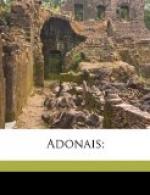+Stanza 27,+ 11. 1-4. ’O gentle child, beautiful as thou wert, Why didst thou leave,’ &c. This is founded on—and as usual spiritualized from—the passage in Bion (p. 64); ’For why, ah overbold! didst thou follow the chase, and, being so fair, why wert thou thus over-hardy to fight with beasts?’
1. 4. ’Dare the unpastured dragon in his den.’ This phrase must no doubt be interpreted, not only in relation to the figurative Adonais. but also to the actual Keats, Keats had dared the unpastured dragon in his den, in the sense that he made a bold adventure into the poetical field, under conditions certain to excite the ire of adherents of the old school, whether in literature or in politics.
1. 6. ’Wisdom the mirrored shield, or scorn the spear.’ Urania arraigns Keats for having made his inroad upon the dragon, unguarded by wisdom or by scorn. His want of wisdom was shown (we may assume) by the grave blemishes and defects in his Endymion, the wilful faults and perverse excesses and extravagances which mark its composition, and wantonly invited attack. His want of scorn was (according to Shelley’s view of the facts), clear enough: he had not been equal to despising a spiteful attack, but had fretted himself to death under it. In terming these two defensive weapons, wisdom and scorn, a mirrored shield and a spear, Shelley was, I apprehend, thinking of the Orlando Furioso of Ariosto. In that poem we read of a magic shield which casts a supernatural and intolerable splendour, whereby every gazer is cast into a trance; and of a spear whose lightest touch overthrows every opponent. A sea-monster—not a dragon, so far as I recollect—becomes one of the victims of the ‘mirrored shield.’
11. 7, 8. ’The full cycle when Thy spirit should have filled its crescent sphere.’ The spirit of Keats is here assimilated to the moon, which grows from a crescent into a spherical form.
1. 9. ’The monsters of life’s waste.’ The noxious creatures which infest the wilderness of human life.
+Stanza 28,+ 1. 1. ’The herded wolves,’ &c. These same ‘monsters’ are now pictured under three aspects. They are herded wolves, which will venture to pursue a traveller, but will not face him if he turns upon them boldly; and obscene ravens, which make an uproar over dead bodies, or dead reputations; and vultures, which follow in the wake of a conqueror, and gorge upon that which is already overthrown. In the succeeding stanza, 29, two other epithetal similes are bestowed upon the monsters—they become ‘reptiles’ and ‘ephemeral insects.’ All these repulsive images are of course here applied to critics of wilfully obtuse or malignant mind, such as Shelley accounted the Quarterly reviewer of Keats to be.




